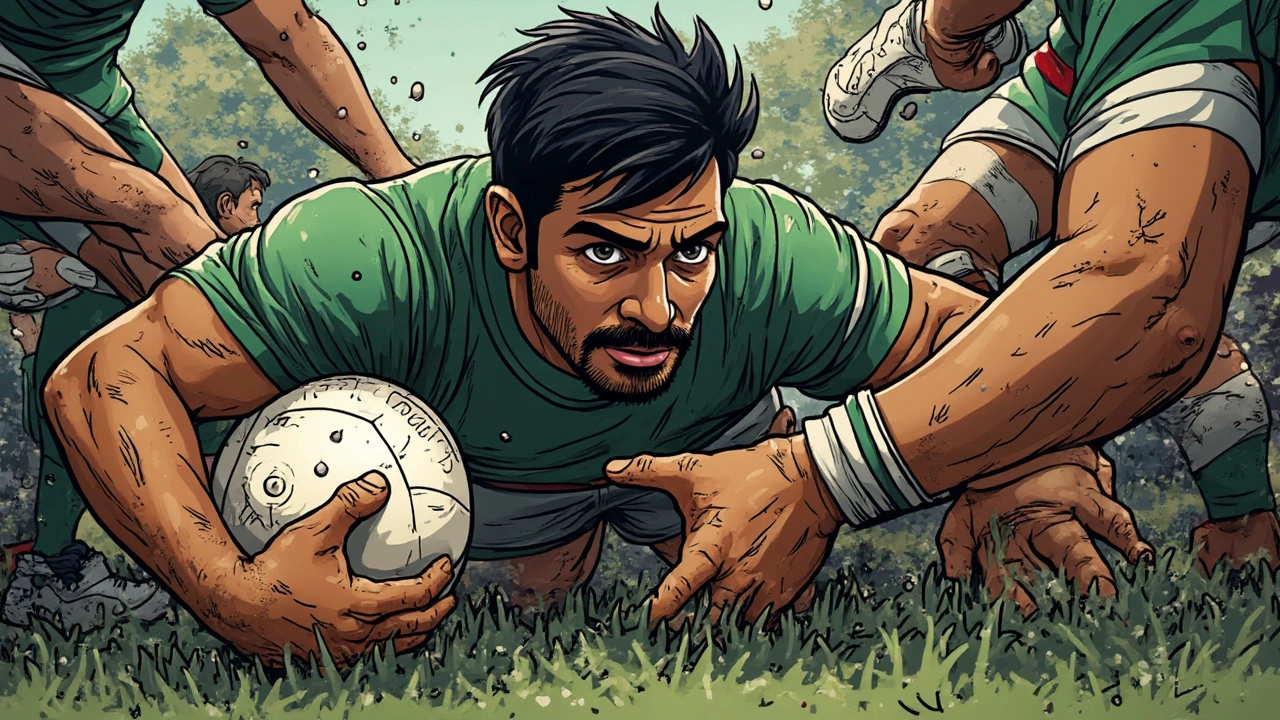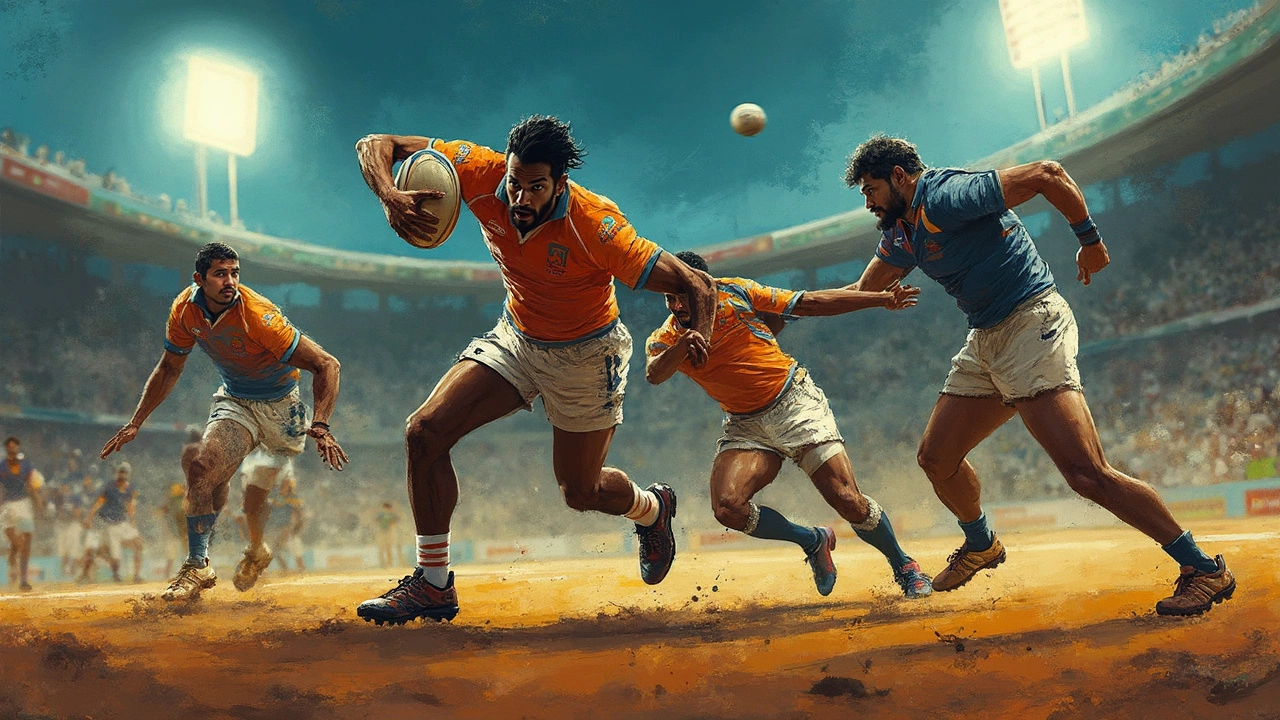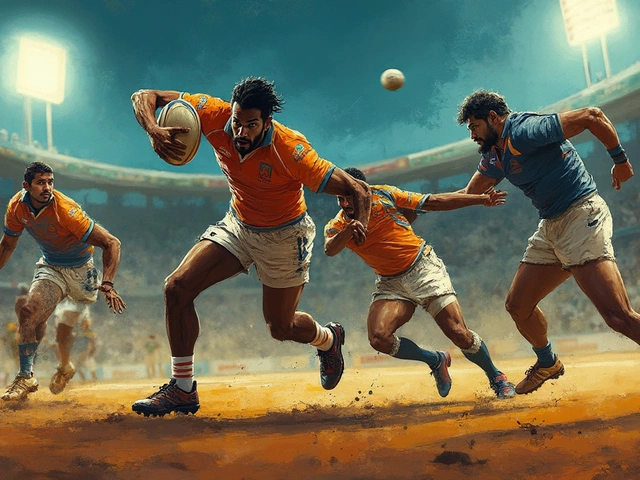Ask anyone who hangs around rugby clubs or rugby WhatsApp groups—this word 'jackler' gets thrown around way more than you’d expect. It’s not a random nickname or another useless bit of jargon tossed in for tradition’s sake. The jackler is the player who dives headfirst into the chaos of the breakdown, arms all over the ball, trying to rip it back from the attacking team. If you’ve ever wondered why those guys in dramatic slow-mo highlights keep stealing the ball at the ruck, you’re talking about jacklers.
The big question, though: why does rugby call this crucial role 'the jackler'? It’s not a word you see anywhere else, except maybe someone at a home improvement store mispronouncing 'jackal.' Stick around, because this rabbit hole leads to wild stories, legendary players, and a part of the game that’s way more technical (and dangerous) than it looks on TV.
- What Is a Jackler?
- Where Did the Name Come From?
- How the Jackler Role Changed the Game
- Spotting the Jackler: Skills and Tricks
- Rules and Safety for Jacklers
- Notable Jacklers and Action Moments
What Is a Jackler?
You hear the word a lot during rugby matches, but what is a jackler, exactly? In simple terms, the jackler is the player who tries to win the ball back at the breakdown—right after a tackle is made and both teams battle to see who keeps possession. A jackler gets down quickly, aims for the ball like a heat-seeking missile, and tries to either rip it away or at least win a penalty for their team.
Most of the time, these players are flankers or openside flankers, sometimes hookers. They’re known for their timing, guts, and technique—get it wrong, and they’re either flattened or pinged for a penalty. Get it right, and suddenly the momentum swings your way. Some people treat it as pure skill; others call it half art and half a street fight.
Here’s what makes a good jackler really stand out:
- Lightning-fast reactions after the tackle is made
- Strong body position over the ball—knees bent, head up, back straight
- Ability to survive massive physical contact while keeping hands on the ball
- Know-how to spot when to go for the steal versus when to hang back
Why is the jackler so important? Look at the numbers—a turnover at breakdown often leads to a try or stops the other team from scoring. Some rugby stat-heads will tell you that a turnover during a match bumps a team’s chance of scoring by up to 30% in the next phase. Want proof?
| Situation | Score Change Likelihood |
|---|---|
| Turnover by jackler | 30% next phase |
| Standard phase play | 10% next phase |
You’ll often hear the commentary focus on the jackler because the modern game leans heavily on this role. Teams are always looking for someone who can grab that key turnover, punish slow support, or draw penalties to take pressure off. If rugby is a battle for ground, the jackler is the one making the opponent earn every inch—or better yet, sending them backwards.
Where Did the Name Come From?
The word ‘jackler’ didn’t just pop up in rugby chat overnight. It’s actually a clever twist on the word ‘jackal,’ which is the animal famous for scavenging. In rugby, a jackler is a player who scavenges for the ball at the breakdown—swooping in quickly when the tackled player is down and trying to wrestle possession back from the opposition. The nickname stuck because the move looks a lot like how a jackal tries to steal scraps from bigger animals. The first uses of the term date back to the early 2000s, around the era when breakdown contests in professional rugby were getting sharper and more competitive.
There’s a fun bit of trivia: players and commentators in the Southern Hemisphere (especially New Zealand and South Africa) started pushing the word into popular rugby culture. A quote from Richie McCaw’s autobiography spells it out:
“You have to be quick, low, and ruthless, a jackal on the ball—otherwise, you don’t just lose the contest, you get trampled.”
The name just made sense, and it spread fast. Soon enough, even coaches and kids’ rugby camps started teaching the ‘jackler’ technique. The reason it stuck? It’s punchy, and it explains exactly what the player does.
Just to put it in perspective, check out how ‘jackler’ grew in use compared to other breakdown-related terms in rugby articles and coaching manuals over the past twenty years:
| Year | 'Jackler' Mentions (Top 3 Rugby Magazines) | 'Turnover Specialist' Mentions |
|---|---|---|
| 2005 | 8 | 35 |
| 2015 | 52 | 29 |
| 2023 | 104 | 17 |
That spike shows just how much the rugby world has embraced the ‘jackler.’ So when you hear coaches barking about needing a reliable jackler, now you know where it all started—and why no one’s going back to the old names.
How the Jackler Role Changed the Game
Rugby before the "jackler" became a thing looked way different. Teams didn’t always have a specialist who picked fights over the ball after a tackle. Once the jackler exploded onto the scene, break-downs turned into hot spots for turnovers. It didn't take long for coaches to start hunting for players with the guts (and wrist strength) to jackal under pressure.
The introduction of this role forced everyone to rethink how they attacked and protected the ball. Suddenly, just running into contact wasn't enough. Teams needed a plan to keep the jackler out or risk coughing up possession. Ball security drills got more intense. Backrow players trained hard to get lower and stay stronger over the ball. Being a good jackler could flip bad defense into points in seconds. Some games literally hinge on a single jackal at the right moment.
Rugby officials kept tweaking the rules to keep things fair (and cut down on broken necks). In 2020, World Rugby updated their laws to make sure jacklers support their weight on their feet, and reach for the ball right after the tackle—no hanging around like leeches. Penalties for “not releasing” or dangerous clear-outs ramped up. The result? Jacklers got quicker, smarter, and the breakdown turned into a mental chess game.
Here’s a quick snapshot of how turnovers by jacklers have shaped recent top-level rugby:
| Year | Avg. Jackler Turnovers Per Game (Pro Rugby) | % of Tries Begun with Jackler Steal |
|---|---|---|
| 2015 Rugby World Cup | 3.4 | 11% |
| 2019 Rugby Championship | 4.1 | 14% |
| 2023 Six Nations | 4.5 | 16% |
Now? No top team leaves home without a master of the jackal. Want to see a defense flip the script? Keep your eye on breakdowns. Jacklers keep everyone guessing, and the ripple effect changes the way every other position plays. Suddenly, it’s not just about size or speed—in rugby, brains and bravery beat brute force every time at the breakdown.

Spotting the Jackler: Skills and Tricks
Ever watched a rugby game and wondered how some players seem to get their hands on the ball at every breakdown? They're not lucky—they’re skilled jacklers, and it's all about timing, body position, and nerves of steel. Here’s what separates an average back-row from the true masters at the ruck:
- Low Body Position: The best jacklers almost squat, keeping their backs straight and hips low. Their chest comes over the ball to create a rock-solid base. It’s tough for defenders to move them without getting penalized for a dangerous clear-out.
- Lightning Hands: Speed is everything. Once the tackle happens, a good jackler is down and latching onto the ball quicker than you can blink. Referees will reward them if they actually beat the arriving support players.
- Strong Grip: Ever tried prying something from a toddler’s hands? That’s a jackler with the ball—they’ve got a death grip. In fact, some pros can deadlift over 200 kilos, which shows just how much grip and arm strength it takes.
- Smart Decision-Making: The breakdown is chaos. Sometimes, the ball’s there for the taking; other times, it’s a penalty waiting to happen. Elite jacklers know when to pile in and when to back off, so their team doesn’t give away easy points.
- Killer Awareness: The real trick is seeing the chance before anyone else. Top jacklers have a sixth sense for loose balls or slow support, and they’re already moving before most players have even reacted.
Here’s a quick cheat sheet that shows what the best jacklers have in their toolkit:
| Key Skill | Why It Matters |
|---|---|
| Low body position | Makes it harder to clear them out |
| Quick entry | First hands on means more turnovers |
| Strong grip | Holds onto the ball under pressure |
| Good discipline | Avoids costly penalties |
| Game awareness | Picks moments that disrupt opposition flow |
If you want to spot a future superstar jackler, watch Academy games. Young players who win turnovers early are usually snapped up for higher levels. And don’t forget, in the last World Cup, teams with high turnover rates at the breakdown had around 65% better odds of making the knockout rounds. The role’s become so important most teams now train not just one or two, but their entire back row to jackal. That’s how vital this messy, gutsy skill set is in the modern game.
Rules and Safety for Jacklers
This is where the breakdown turns into a chess match mixed with contact sport intensity. The jackler’s moment—trying to win that ball—attracts more law changes than just about any other thing in rugby. The reason? Players kept getting hurt, and matches sometimes turned downright ugly at the ruck.
Here are the big points you should know about the rules for jacklers:
- The jackler can only go for the ball if they get there after a tackle, stay on their feet, and show clear release from the tackled player before trying to steal. If you skip any of those, there’s a whistle in your future.
- As soon as a ruck forms (meaning at least one player from each side is bound over the ball), hands are off—no playing the ball with your hands then. You’ll see referees talk about “no hands in the ruck.”
- Neck rolls and high contact are major red cards waiting to happen. Safety first. If defenders grab around the jackler’s head to clean him out, that’s a penalty, maybe a ban.
- Referees tell jacklers to "show daylight"—meaning after a tackle, you have to clearly release the ball carrier before making a play. It prevents cheap turnovers and makes sure everyone has the same shot at the ball.
The laws keep evolving. For example, since 2021, World Rugby has put a huge spotlight on safety at the jackler position. A study in 2019 showed nearly 34% of serious breakdown injuries came from tacklers trying to steal the ball (mostly shoulder or concussion-related). Referees now allow a tiny window—roughly one second—to win the ball, then you need to leave it alone or risk a penalty.
Take a look at how some breakdown injuries stack up (based on World Rugby injury data):
| Type of Breakdown Injury | Percent of All Breakdown Injuries |
|---|---|
| Shoulder Dislocation/Sprain | 31% |
| Concussion/Head Injury | 28% |
| Knee or Leg Injury | 18% |
| Neck/Spine Trauma | 7% |
If you’re eyeing the jackler role, learn to get in and out quick—no camping out over the ball. Keep your body low, brace your neck, and watch the referee’s signals closely. And coaches these days? They drill jacklers on safe body position way more than glory steals. Winning this contest is about smarts and reaction, not just strength or guts.
Notable Jacklers and Action Moments
Every era in rugby has its standout jacklers—players who practically have a sixth sense for sniffing out turnovers. These guys have built reputations on disrupting rucks and flipping games on their heads. If you’re trying to understand this role, checking out the best jacklers in rugby history will give you a clear picture of what’s possible.
Probably the most famous jackler of the modern game is Richie McCaw. He won over 140 caps for New Zealand, and half the time it felt like he was getting hands on the ball before anyone else could even blink. His timing at the breakdown is legendary. People in pubs still argue about how many turnovers he actually won—the breakdown didn’t track stats back then like it does now—but if you watched him, you know. Another big name is David Pocock from Australia. Pocock specialized in pilfering the ball, sometimes winning double-digit turnovers in a single match. Then there’s Sam Warburton, who captained Wales, and he was shamelessly low to the ground, using body position to make himself almost impossible to move.
For current players, Tom Curry (England) and Ardie Savea (New Zealand) are all about aggression at the ruck. Curry, especially, is known for his precision—if there’s a loose ball, he’s likely coming away with it. Savea, meanwhile, mixes speed and power with a bit of wild flair. And you can’t leave out Siya Kolisi from South Africa. Kolisi isn’t just his team’s talisman; he’s also good for one or two clutch turnovers when it matters.
Here’s a stat check from recent Rugby World Cups to put things in perspective:
| Player | Team | Turnovers Won (2019 RWC) |
|---|---|---|
| Ardie Savea | New Zealand | 12 |
| Tom Curry | England | 10 |
| Siya Kolisi | South Africa | 7 |
| Samu Kerevi | Australia | 8 |
What puts these guys above the rest? It’s not just muscle. quick thinking, crazy balance, and the guts to stick your head where knees and boots are flying matter just as much. Knowing when to commit, how to keep your feet, and reading the ref’s mood—these things decide whether you pull off a clean jackal or give away a penalty.
Some of the most jaw-dropping action moments from jacklers come in tight matches, where a single turnover changes everything. Remember when Sam Warburton poached the ball during the 2013 Lions tour and set up a winning attack? Or Pocock wrecking England’s chances at the 2015 World Cup by stealing ball after ball near his own try-line? If you’re starting out, watch highlights of these guys. You’ll get a feel for what the jackler is all about, and why coaches lose sleep over finding or stopping a great one.


